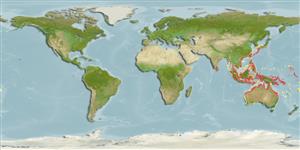Common names from other countries
Environment: milieu / climate zone / depth range / distribution range
экология
; солоноватоводный. Tropical
Indo-West Pacific: from India to Vanuatu; north to southern islands of Japan, and south to Queensland and New Caledonia.
Length at first maturity / Size / Вес / Возраст
Maturity: Lm ? range ? - ? cm Max length : 10.5 cm SHL самец/пол неопределен; (Ref. 348); common length : 7.0 cm SHL самец/пол неопределен; (Ref. 348)
Widely collected as food in Asia (Ref. 348). Found in intertidal areas in mangrove mud (Ref. 75831, 85174). Also in fresh and brackish waters of mangrove swamps, estuaries, and larger rivers. Highly tolerant to surface desiccation of its habitat; can survive by aerial respiration at the posterior mantle margin for a period of a few days, and feed from subterranean water by means of water exchange through a narrow anterior gape of valves (Ref. 345).
Life cycle and mating behavior
половая зрелость | размножение | нерест | икра | Fecundity | личинки
Members of the class Bivalvia are mostly gonochoric, some are protandric hermaphrodites. Life cycle: Embryos develop into free-swimming trocophore larvae, succeeded by the bivalve veliger, resembling a miniature clam.
Основная ссылка
ссылки | координатор | соавторы
Poutiers, J.M. 1998. (Ref. 348)
Статус Красного Списка МСОП (Ref. 130435)
Статус СИТЕС (Ref. 108899)
Not Evaluated
Not Evaluated
Угроза для людей
Harmless
Использование человеком
| FishSource |
инструменты
дополнительная информация
ресурсы в Интернет
Estimates based on models
устойчивость к внешним воздействиям
высокий, минимальное время удвоения популяции до 15 месяцев (K=0.76).
Уязвимость
Low vulnerability (10 of 100).
Категория цены
Unknown.
